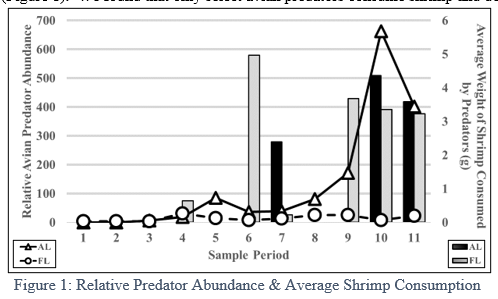AVIAN PREDATION ON LOW-SALINITY SHRIMP AQUACULTURE
Pacific white shrimp (Litopenaeus vannamei ) is the most commonly produced shrimp in the world and prominent in the seafood industry in the United States. Aquaculture producers in the United States raise >2,000 metric tons of shrimp each year using various low-salinity water (LSW) sources . Although many bird species frequent aquaculture facilities and are known or suspected of consuming shrimp, no studies have examined the impact these birds may have on final yield. Therefore, our objectives were to 1) assess the distribution and relative abundance of predatory birds on commercial shrimp farms in Alabama and Florida, 2) quantify the diet of these birds, 3) and estimate the total amount of shrimp consumed annually.
During May-October 2020, we conducted biweekly surveys to estimate the diversity and relative abundance of birds and then conducted collections of individuals observed actively foraging around shrimp production ponds at farms in Alabama and Florida. Collected birds were injected immediately with cold (<10° C) phosphate buffered saline to halt digestion and placed on ice. Necropsies were then performed to determine the diets of each bird. A total of 58 birds (7 species) were collected with most (n=34) being collected closer to the harvesting months of September and October. Of these 34 birds, 21 (61.8%) had consumed shrimp with Pied-billed Grebes (Podilymbus podiceps), Great Egrets (Ardea alba), and Double-crested Cormorants ( Phalacrocorax auritus) consuming the most shrimp. Pied-billed Grebes consumed an average 1.67g dry weight shrimp/bird, Great Egrets consumed 1.85g, Double-crested Cormorants consumed 5.34g, Great Blue Herons consumed 1.32g, and Little Blue Herons consumed 0.47g (Figure 1). We found that only select avian predators consume shrimp and do so closer to harvest when shrimp are mature and pond waters are lowered suggesting that management actions to mitigate losses may be targeted to a few species and may be most effective immediately before shrimp are harvested.
